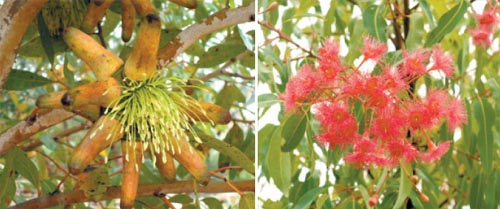Exotic Aussie flora to get brand-new home

Two Australian trees, Eucalyptus lehmannii and Corymbia ptychocarpa, will be in the Australian garden. Provided by the Korean National Arboretum
The distinct scent of the eucalyptus tree and the fiery colors of the grevillea flower will soon become more familiar to Koreans. A permanent Australian garden including plants that are national emblems will be opened at the Korea National Arboretum in the second half of this year.
The new garden is part of a redevelopment of the arboretum greenhouse to increase the public’s understanding of plant diversity and preservation.
The garden will display trees native to Australia, including the grass tree, bottle tree, banksia, eucalyptus and acacia. These unusually shaped trees will be complemented with vivid flowers such as the waratah and grevillea.
Utchang Kang, a botanist at the Korea National Arboretum, hopes the garden will enhance cultural and ecological awareness among visitors. “I hope Koreans will get to know the beauty of the Australian plants, and eventually they shall take more heed of the importance of preserving plant diversity,” he said.
The Australian garden is a joint venture between the Korea National Arboretum and Australian Botanic Gardens Trust. While some of the plants are national symbols and familiar to Australians, both organizations believe that Koreans will be captivated by the unique foliage. “We trust that visitors will be inspired by the unusual sight of such strange foreign plants and seek to learn more about our country and plant life,” said Daniel Bishop, Manager of Horticulture at the Australian Botanic Gardens Trust.
The garden will be divided into three different themes based upon the “many wonders of the wild landscapes”: mallee (which are woodlands and shrublands), heathland (dwarf-shrub habitat) and inland desert. Kang said the themes will highlight the diversity and beauty of Australian plants. “Australia has very unique features in terms of plant distribution, flora and ecosystems because many Australian plants have different pathways of evolution.”
Kang and his team visited Australia last May to select the plants. After consulting with the horticultural staff at the Australian Botanic Garden in Mount Annan, they came up with a “wish list” of species. The list was based upon three factors: the uniqueness and beauty of the plants, seed availability and their ability to grow in Korea’s considerably colder climate.
The plants will grow in a greenhouse at the arboretum, which will have a minimum temperature of four degrees Celsius (39 degrees Fahrenheit) during winter.
Most of the plants will arrive in Korea in the form of seeds from the New South Wales Seedbank. A small selection will be sent as fresh cuttings, as this is the only means for them to successfully propagate. As well as providing the seeds, the Australian Botanic Gardens Trust will assist with the design of the plant display and offer ongoing advice to the arboretum on propagation and maintenance.
The Korea National Arboretum began planning the garden in 2009 and officially launched its relationship with the Australian Botanic Gardens Trust that year. The cooperation was initiated through the Australia-Korea Foundation to encourage interaction in horticulture between the countries.
The opening of the Australian garden later this year - an exact date has yet to be set - will coincide with the Year of Friendship between Korea and Australia, which celebrates 50 years of diplomatic ties.
The Korea National Arboretum is located at 51-7 Jikdong-ri, Soheul-eup, Pocheon, Gyeonggi.
By Philip Chan Intern reporter [enational@joongang.co.kr]










with the Korea JoongAng Daily
To write comments, please log in to one of the accounts.
Standards Board Policy (0/250자)